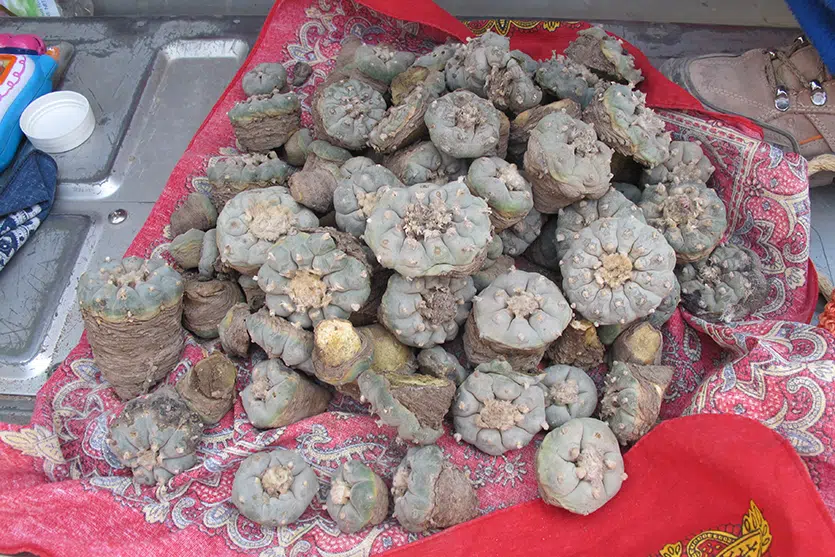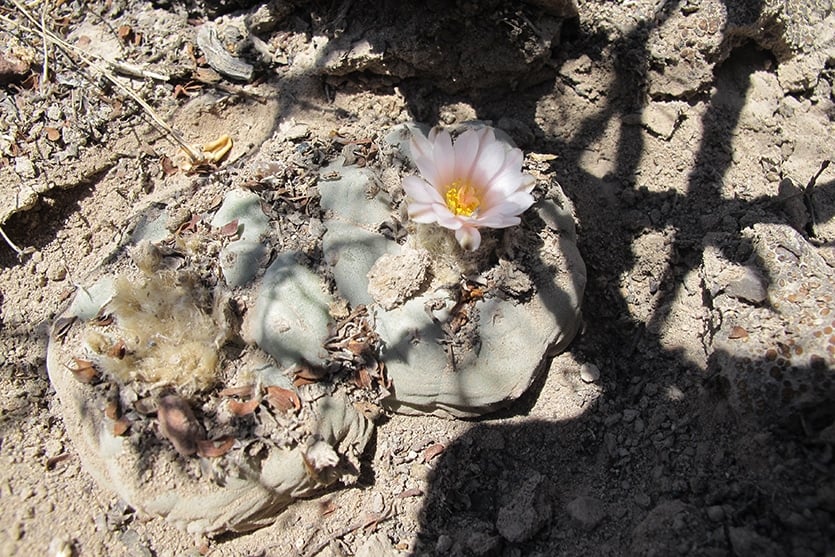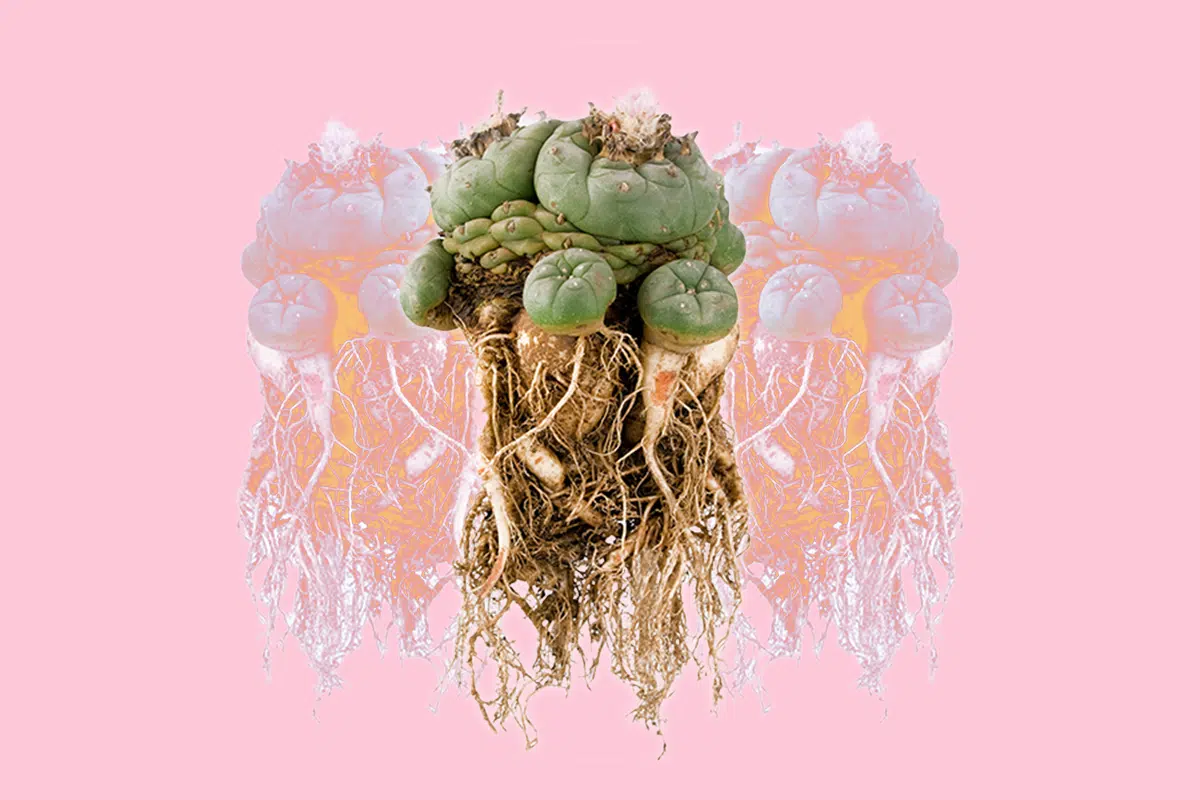The story of peyote is something like a fairytale, beginning in a time long ago and containing what could be called magic by those who utilize it for healing. However, today’s reality for the Indigenous people who consider it sacred is anything but. Peyote has become a controversial topic of late; tracing back its origins can help us understand why.
What is Peyote?
Peyote, whose scientific name is Lophophora williamsii, is a small spineless cactus containing psychoactive alkaloids—namely mescaline—and is considered to be a vulnerable plant whose population is decreasing today. Given that the cactus needs five to 20 years to mature and be harvestable—even longer to mature to a size that can reliably multiply and regenerate itself when harvested properly—this problem is not one that can be solved easily or quickly. Several factors have led to peyote’s delicate status, including: over- or incorrect harvesting (done in such a way that the plant does not retain its roots and thus does not regenerate), illegal poaching, cattle ranching, mining, and oil and energy production, as well as increased land use for agriculture.
Peyote’s story is a complex one, spanning many years and even more miles. What began as sacrament in Native American ceremonies has now become a plant on the brink of becoming endangered. In the wide-ranging efforts to decriminalize entheogens, many believe peyote should not be included; that it should be left to the Indigenous people to conserve and protect. But others think that non-Natives have the right to cultivate it, and that peyote should be decriminalized on a legal level. This issue has caused a deep rift in the peyote story—let’s delve in to the complex tapestry that forms peyote’s journey.

Peyote History
Beginning more than 10,000 years ago, the fated partnership between people and peyote was born in the arid scapes of what is now called Mexico. Indigenous peoples discovered the psychoactive and spiritual effects of the plant, and have relied on it ever since. These include the Wixaritari (Huichol), Yaqui, Cora, and Raramuri (Tarahumara). In the 19th century, peyote found its way to more northern regions of the North American continent along trade routes. It quickly became an integral part of Native Americans’ spiritual ceremonies for healing. The peyote gardens in Texas, where the medicinal, psychedelic cactus grew naturally, became places of pilgrimage for Native tribes of the southwest to collect peyote and bring it back to their people.
In 1918, in order to protect the plant’s sacramental use, Native American Churches were formed. According to Miriam Volat, executive director of the Indigenous Peyote Conservation Initiative (the IPCI) and co-director at the Riverstyx Foundation, which works with Indigenous peoples on the preservation of sacred plant medicines, the main threat at that time was incarceration from authorities: “The government was prohibiting ceremonies and use of medicine at that time. In 1918, there were nine different tribes represented by the NAC (Native American Church). Leaders came together to protect their spiritual ceremonies and called it a church because they felt that was something the government would understand. They would place a Bible somewhere, so that if police came in, they would say it was a church. The NAC now represents over 50 tribes.” While the popularity of peyote for sacred ritual amongst Native Americans continued consistently in the following decades, the legality of its use was anything but.
In 1978, Congress enacted the American Indian Religious Freedom Act (subsequently amended in 1996), which protected the rights of members belonging to legally-recognized tribes to possess, transport, and utilize peyote for religious ceremonies. At the beginning of the 21st century, due to concern over the decline in the availability of peyote and Native access to the land in southwestern Texas where it grows natively, the Native American Church of North America (NACNA) commissioned the “Peyote Research Project.” This project both laid out the issues surrounding declining access of Indigenous people to the sacred plant, and outlined a proposal identifying strategies to secure sovereign land.
How to Grow Shrooms Bundle
Take Both of Our Courses and Save $90!
In 2017, the National Council of Native American Churches, or NCNAC (comprising four churches), with support from the Riverstyx Foundation, purchased just over 600 acres of peyote land from a natural gas company (a.k.a. the medicine gardens) to establish and preserve a designated space for peyote cultivation. This space spans some 1200 square miles from El Paso to Laredo. Shortly after, the National Council held their first ceremony and launched the IPCI. The following year, the IPCI became a 501c(3) organization, advocating for the peyote lands and for Indigenous people from Mexico, the US, and Canada.

Is Peyote Endangered?
The IPCI works on several levels: reconnecting Indigenous people to the peyote plant and how it is harvested, promoting regrowth to preserve it for future generations through conservation, hosting pilgrimages, protecting the medicine itself, as well as distribution and overseeing the development of peyote’s spiritual homesite in Texas (with plans for a welcome center, a museum, housing, and facilities for youth engagement). In terms of the environmental concerns surrounding peyote, the potential effects of climate change on the cacti are still unknown, according to a paper by Anya Ermakova, PhD and Martin Terry, PhD.
“It’s really important to talk about the situation itself because it’s actually really serious ecologically,” says Volat (of Riverstyx and the IPCI). “In the US, there is only this very small area in Southern Texas where there’s native peyote habitat, and that habitat is severely compromised. Peyote is a threatened species, which means that there are extreme pressures on the gardens. Along with agricultural practices, strip tillage, windmill production, solar panels, natural gas pads, and all the other things that disrupt the soil surface and rip up plants without allowing them to grow back, there are also really intensive pressures from improper harvesting and over-harvesting. This includes poaching, which has increased dramatically since I’ve been working as an ecologist and facilitator down here. It’s heartbreaking.”
Read: Mining and Poaching Threatens 15,000-Year-Old Peyote Tradition in Mexico
Two of the main players in the peyote story in southern Texas are the pickers and the peyoteros. Peyoteros are the only ones licensed by the DEA to sell peyote to those who have cards showing their federally-recognized Native American status. As is so often the case, increasing demand leads to a desire for more supply, which in practical terms means the plant is harvested too early, when it’s too young. Overharvesting leads to reduced sexual reproduction and, in turn, a loss of genetic diversity, thereby posing a large threat to the continuing survival of this species in the wild. The convergence of these myriad factors has led to significant decline in both US and Mexican peyote plants, and if things continue like this, peyote could well become extinct in 30 years.
Bia Labate, executive director of Chacruna, which provides education and cultural understanding about psychedelic plant medicines while promoting a bridge between their ceremonial use and science, shared what she believes to be the wins and setbacks in the fight for peyote conservation. Labate explained that there are projects such as IPCI and Sia, a nonprofit aimed at eagle conservation and peyote cultivation, charting legal pathways for peyote cultivation and consumption, and reconnecting people to the land. But she worries that the conversation around peyote conservation has become too polarized.

Is Peyote Legal?
As the psychedelic movement gains momentum in the United States, a debate has emerged over whether or not to include peyote in decriminalization measures. Many believe that it is crucial—due to the historical, spiritual, and cultural relationship Native Americans have with this sacred plant and its native habitat—that decision-making regarding peyote preservation be led by them and them alone. SB 519, California’s pending measure concerning the decriminalization of psychedelics does not include peyote for those reasons.
Decriminalize Nature—a group which began in Oakland, but has independent local chapters around the country to decriminalize naturally-occurring psychedelics—has taken a different stance. Their position is that the decriminalization of the cultivation of peyote, for both Indigenous and non-Indigenous people, is integral to ensuring the cactus does not go extinct by decreasing poaching in the wild. They say their stance is informed by a desire to preserve access to peyote for Indigenous communities with an ancestral tie to it. In a recent Instagram post they wrote, “We honor the work of those who created the Native American Church by pursuing broader, more open models of liberation based on the realities of today.” The group is hoping to gain the support of both the US and Mexican federal governments in their efforts.
“In May 2021, the six member national board of Decriminalize Nature, which includes three people of Indigenous ancestry from the US and Mexico, voted unanimously to continue advocating for decriminalizing personal cultivation of peyote in the US because we believed it to be the best strategy for preventing peyote extinction in the wild,” Carlos Plazola, Decriminalize Nature co-founder, wrote to DoubleBlind. “For over 100 years, wild peyote populations have been shrinking even with criminalization policies in place. It’s time to try a new approach. In May 2022, scientists from the Cactus Conservation Institute released a crucial scientific analysis and their conclusion was that ‘cultivation is not only (a) necessary conservation strategy for this particular species but is likely the only viable alternative for long-term survival of this cactus in the wild.’ We agree.”
Labate, along with cultural anthropologist and attorney Kevin Feeny, PhD, published an article on Chacruna criticizing Decriminalize Nature. “Decriminalization efforts that exclude Native Americans from the process, or that use tokenization to advance their goals against clear denouncements from organizations representing a myriad of Native voices, do not solve the problems of peyote prohibition, but rather act as an oppressive, divisive, and neocolonial force,” they wrote.
Read: Native Tribes Should Have More Say in the Psychedelic Movement
In an open letter written by the NCNAC and the IPCI, the two organizations made a strong and clear argument in favor of not decriminalizing peyote. While the letter was not informed by a pro-prohibition stance, the impetus behind it was to showcase the far-reaching conservation strategy that is already underway by these Indigenous bodies. This includes regulatory and legal measures designed to secure biocultural preservation. The NCNAC and the IPCI asked for these efforts to not be interfered with or interrupted, which could be an unintended consequence of including peyote in more widespread striving for decriminalization of other psychedelics. These groups are working to protect both the spiritual and ecological sustainability of peyote and certain Indigenous groups have expressed worry that the fruits of this labor could be disrupted by lumping peyote in with other psychedelic decriminalization efforts; the idea is that the fight regarding peyote policy should be in the jurisdiction of people with long-standing generational ties to this sacred plant.
In a conversation with DoubleBlind, cactus expert and advocate Max Montrose expressed frustration with the idea that those who don’t have a heritage of sacred peyote use shouldn’t be able to use it or cultivate it. “I understand where they are coming from,” he says, noting how much has already been taken from Indigenous peoples that it makes sense to be protective over peyote—and yet, he adds, according to federal precedent (laid out in the Boyll vs. US case of the early Nineties), “you don’t necessarily have to be a card-carrying member or associated with the Native American Church to use it in a legally bonafide way. You just have to prove that your peyote use is bonafide. If I were ever caught for using peyote, and I had to save myself from going to jail, I’d be able to prove that every time I’ve engaged in the use of peyote, it’s religious. I always do it in ceremony [with sacred tools and prayer accessories], and if you were to call my Rabbi and ask her, I talk to God when I use peyote and she knows this is a real thing for me.”
But beyond that, Montrose argues, using peyote that he’s grown himself does not threaten the peyote supply to go around. “If I’m not allowed to grow my own peyote, I have to get it from the Native American Church or the wild,” he says. “There is zero negative effect on the Native American people and the peyote plant if I cultivate it and use it myself.”
The National Council and IPCI have issued formal requests to the decriminalization movement—specifically Decriminalize Nature—as well as the psychedelic movement as a whole, to respect their position and discontinue all efforts to include peyote with substances such as natural entheogens like psilocybin, or broader psychedelic compounds like LSD. Given that NCNAC is comprised of the presidents of the four largest and oldest umbrella of Native American Churches, which in turn, represent the vast majority of authentic Native American Churches (from Oklahoma, South Dakota, and Azee’ Bee Nahagha of Dine Nation), this letter represents a significant contingent of the Indigenous peyote preservation and reclamation movement in America. These umbrella organizations represent approximately 200 church chapters and 45 tribal groups.

Given that over 45 Native American tribes, each with their own particular methods and customs, rely on peyote as a sacred ritual medicine, its conservation must include many different strategies: Some tribes will want to have greenhouses to supply all of their community needs; while others will conduct pilgrimages to the gardens in Southwestern Texas; while still others will have nurseries either in the peyote lands or will collect seeds for their own nurseries. Some tribes wish to be more autonomous when it comes to growing and harvesting, while others will go through larger affiliate organizations. One consistent element is that tribal youth are being taught by their elders (through the IPCI) how to care for and harvest the peyote, and intergenerational Indigenous wisdom and practices are being shared in a concerted fashion on a wide scale for the first time in many years.
“The basic position at this point is when it comes to peyote, which is the medicine of this land and the medicine of the Native people of this land, how about if there’s any changes to regulations on a governmental level that impacts our medicine, how about if that’s NAC-led?” says Volat. “How about if those people who have a sacred responsibility to take care of that medicine be the ones who handle it? So they have asked it to be left out so that they can handle it themselves. To me, you have to be able to see the ecological issues and how amazing it is for communities to be taking their own responsibility for that. It’s a test case for the psychedelic movement.”
Peyote’s status as a vulnerable plant species has motivated some psychedelic enthusiasts to look for alternative solutions. One of these is synthetically-produced mescaline, along with cultivation of other mescaline-rich cacti, like San Pedro, offering a more ethical and sustainable solution.
How to Grow Shrooms Bundle
Take Both of Our Courses and Save $90!
The principal active psychoactive ingredient in peyote, termed 3,4,5-trimethoxy-β-phenethylamine, or mescaline, was not identified and isolated until 1897 by German chemist Arthur Heffter. Until then, the usage of peyote had been unsuccessfully suppressed by Catholic missionaries who believed that the plant enabled communication with the devil. However, in the late 19th century, Western scientists and researchers became increasingly fascinated by hallucinogenic substances, such as ether. Heffter’s discovery of mescaline spurred a slew of clinical trials to see if the drug could be utilized to model psychosis and thereby illuminate its inner workings.
In 1918, Viennese chemist Ernst Späth pioneered a unique synthesis of mescaline from common chemical building blocks and corrected an error in the molecular structure originally proposed by Heffter. Mescaline became the prototypical psychedelic drug and was used as the benchmark by which other entheogens would be measured. Aldous Huxley further thrust mescaline into the proverbial limelight with his book, The Doors of Perception, where he writes about his psychedelic experiences and how they influenced his life, his writing, and his very person. The 1960s brought with it many a flower child who would travel in bell-bottoms down to Texas or Mexico to try peyote and experience what they understood to be its transcendent effects.
Read: What is Mescaline?
With the current legislation in the US around peyote, harvesting the plant legally is virtually impossible for those who are not members of the Native American Church. Illegally, most peyote grows on private land, and procuring it requires trespassing. This combination makes for an impractical source of mescaline. Once again, synthetic mescaline could be a good alternative (although it’s still not legal). Synthetic mescaline has not been proven to be addictive and has been found to have the same healing effects as the beloved cactus itself. However, on the “black market,” you have to ensure that what you’re getting is in fact synthetic mescaline and not something else, as the term can be widely and inaccurately applied. As with anything, it is imperative to know and trust your source.
Peyote’s story is far from over, and only time will tell whether the cherished cactus will survive for future generations to nurture, harvest, and benefit from spiritually. When asked where she’d like to see peyote five years from now, Labate says that “the context of the political and economic systems in which the ‘psychedelic renaissance’ is emerging depend on extraction of resources and exploitation of labor from the Global South, which has resulted in the accumulation of wealth and profits into a small number of hands. There is, in general, a lack of historical and cultural awareness. While millions of dollars continue to be poured into the new ‘psychedelic eco-system,’ Indigenous people continue to be murdered throughout the Americas, their lands invaded, and their culture and spirituality vulgarized.”
Labate expressed shame at the ways that many in the field of psychedelics have treated Native Americans, and hope that Native Americans regain their trust in the psychedelic community and that Indigenous rights are respected beyond the projected imaginary relationship to the “wise Indians who discovered these sacred plants.” She hopes to see strong greenhouses and re-planting peyote in the wild led by Native Americans in the US and to see more dialogue across Mexico and US, as well as academic research on the topic.
According to Volat, “Most of the NAC church tribes got the medicine in its current [legal] form along with colonialism, I always think that’s important to remember. All of the healing centers around colonial trauma. The plant itself is rare and precious, and the culture and the way of life that is deeply connected to the Indigenous people of the US having their own mental and community healthcare system that addresses all of post-colonial ills, physical, mental and spiritual that are a part of our history, this is a medicine that helps them to do that.”

DoubleBlind is a trusted resource for news, evidence-based education, and reporting on psychedelics. We work with leading medical professionals, scientific researchers, journalists, mycologists, indigenous stewards, and cultural pioneers. Read about our editorial policy and fact-checking process here.

DoubleBlind Magazine does not encourage or condone any illegal activities, including but not limited to the use of illegal substances. We do not provide mental health, clinical, or medical services. We are not a substitute for medical, psychological, or psychiatric diagnosis, treatment, or advice. If you are in a crisis or if you or any other person may be in danger or experiencing a mental health emergency, immediately call 911 or your local emergency resources. If you are considering suicide, please call 988 to connect with the National Suicide Prevention Lifeline.



